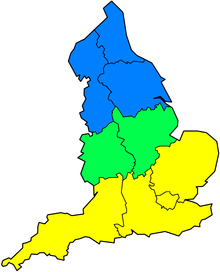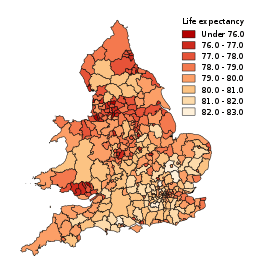Southern England
Southern England, or the South of England, also known as the South, refers roughly to the southern counties of England. The extent of this area can take a number of different interpretations depending on the context, including geographical, cultural, political and economic. Southern England also shares a border with The Midlands. Geographically, the south of England covers about one-quarter of the United Kingdom. The South is often considered a principal cultural area of England, along with the Midlands and Northern England. Many consider the area to have a distinct identity from the rest of England, however without universal agreement on what cultural, political, and economic characteristics of the South are.
Southern England South of England | |
|---|---|
| Nickname(s): The South | |
 In this image, official definitions of Southern England are illustrated as yellow. | |
| Sovereign state | |
| Country | |
| Historic counties | |
| 10 largest Settlements in order of population | |
| Area | |
| • Total | 62,042 km2 (23,955 sq mi) |
| Population (2011) | |
| • Total | 27,945,000 |
| • Density | 450/km2 (1,200/sq mi) |
| • Urban | 22,806,000 |
| • Rural | 5,139,000 |
| Demonym(s) | Southerner |
| Time zone | GMT (UTC) |
| • Summer (DST) | UTC+1 (BST) |
For statistical purposes, Southern England is divided into four regions: South West England, South East England, London, and the East of England. Combined, these have a total area of 62,042 square kilometres (23,955 sq mi), and a population of 28 million.
People
People often apply the terms "southern" and "south" loosely, without deeper consideration of the geographical identities of Southern England. This can cause confusion over the depth of affiliation between its areas. As in much of the rest of England, people tend to have a deeper affiliation to their county or city. Thus, residents of Essex are unlikely to feel much affinity with people in Oxfordshire. Similarly, there is a strong distinction between natives of the south-west and south-east. The broadcaster Stuart Maconie has noted that culturally "there's a bottom half of England [...] but there isn't a south in the same way that there's a north".[1]
Health

One major manifestation of the North–South divide is in health and life expectancy statistics.[2] All three Northern England statistical regions have lower than average life expectancies and higher than average rates of cancer, circulatory disease and respiratory disease.[3][4] The South of England has a higher life expectancy than the North, however, regional differences do seem to be slowly narrowing: between 1991–1993 and 2012–2014, life expectancy in the North East increased by 6.0 years and in the North West by 5.8 years, the fastest increase in any region outside London, and the gap between life expectancy in the North East and South East is now 2.5 years, down from 2.9 in 1993.[4] Furthermore, all such figures represent an average - affluent northern towns such as Harrogate have higher life expectancies than less affluent areas of the South such as Southampton or Plymouth.
Sport
Rugby
The sport of rugby experienced a schism in 1895 with many teams based in Yorkshire, Lancashire and surrounding areas breaking from the Rugby Football Union and forming their own League. The disagreement that led to the split was over the issue of professional payments, and "broken time" or injury payments. There is a perception that league is the code of rugby played in the north, whilst union is the code played in the south. One of the biggest derbies in Southern England is the West Country derby (Bath v Gloucester).[5]
Football
The South Coast Derby is used to describe football matches played mainly between Portsmouth Football Club and Southampton Football Club.
However in Portsmouth's absence from top flight football, AFC Bournemouth and Brighton and Hove Albion – based about 30 miles (48 km) and 60 miles (97 km) from Southampton respectively – gained promotion to the Premier League, with some media outlets marketing fixtures against them as a 'South Coast derby';[6][7][8]
Other major derbies in Southern England are West Country derbies and ones held in London which are know collectively as London derbies.[9][10]
Divisions
In most definitions, Southern England includes all the counties on/near the English Channel. In terms of the current ceremonial counties:
Despite the general acceptance of these counties as Southern, those that comprise the West Country are occasionally considered mutually exclusive to Southern England.
The exact northern extent varies and as with most geographical regions, people sometimes debate the boundaries. In the west, Southern England is generally taken to include Gloucestershire and Oxfordshire; in central Southern England, the counties of Bedfordshire, Buckinghamshire and Hertfordshire; to the east, Essex and the counties of East Anglia (Cambridgeshire, Norfolk and Suffolk). For a period of time between the 16th and 20th Centuries, the county of Monmouthshire in Wales was often considered English due to both politics and the result of these having a cultural impact on the people who lived there. Therefore, in these instances it was grouped with southern England due to its border with Gloucestershire.
Despite these definitions, the northern boundary is generally taken to correspond to an imaginary line from the Severn Estuary to the Wash (or expressed in terms of towns, from Gloucester to King's Lynn).
See also
References
- Maconie, Stuart (2007). Pies and Prejudice: In Search of the North. Ebury Press. p. 1. ISBN 978-0-09-191022-8.
- Kirk, Ashley (15 September 2015). "Life expectancy increases to 81 years old - but north-south divide remains". Daily Telegraph. Archived from the original on 15 March 2017. Retrieved 14 March 2017.
- Ellis, Amy; Fry, Robert (2010). "Regional health inequalities in England" (PDF). Office for National Statistics. Archived from the original (PDF) on 5 January 2016. Retrieved 14 March 2017.
- Olatunde, Olugbenga (4 November 2015). "Life Expectancy at Birth and at Age 65 by Local Areas in England and Wales: 2012 to 2014". Office of National Statistics. Archived from the original on 15 March 2017. Retrieved 14 March 2017.
- "Gloucester v Bath: The legend of the West County derby". BBC. 11 April 2014. Retrieved 23 April 2015.
- AFC Bournemouth: What should we call the derby between Cherries and Southampton?, Bournemouth Daily Echo, 30 October 2015
- Southampton snatch equaliser against Brighton in the south coast derby but remain in the relegation zone, The Independent, 31 January 2018
- Bournemouth against Southampton the “other” South Coast Derby, Vital Football, 18 October 2018
- "London derbies ranked on ferocity of rivalry, including Tottenham v Arsenal and West Ham v Chelsea". TalkSport. Retrieved 21 February 2017.
- "The 10 biggest rivalries in London football". The Telegraph. Retrieved 22 February 2017.